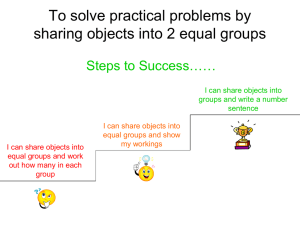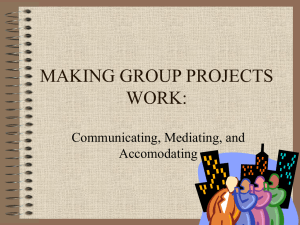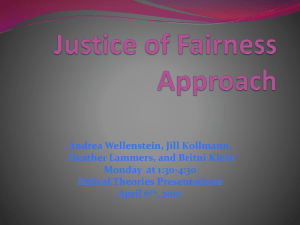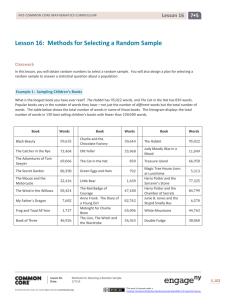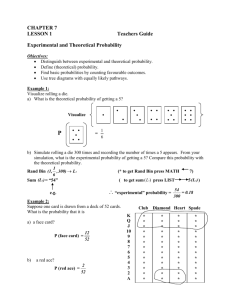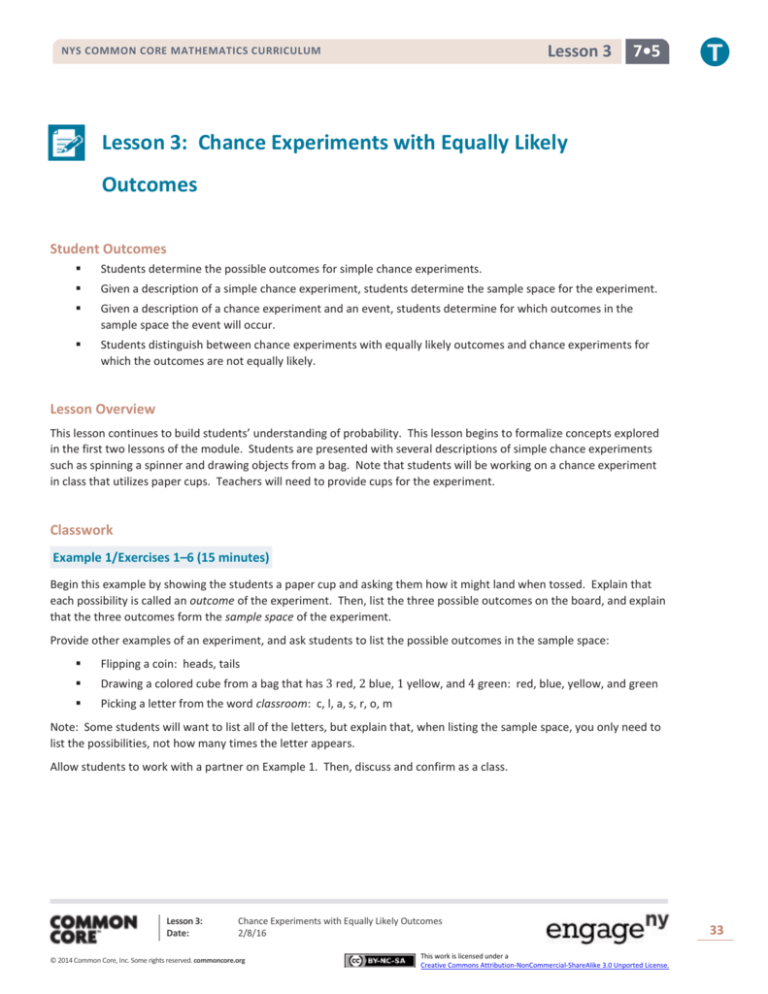
Lesson 3
NYS COMMON CORE MATHEMATICS CURRICULUM
7•5
Lesson 3: Chance Experiments with Equally Likely
Outcomes
Student Outcomes
Students determine the possible outcomes for simple chance experiments.
Given a description of a simple chance experiment, students determine the sample space for the experiment.
Given a description of a chance experiment and an event, students determine for which outcomes in the
sample space the event will occur.
Students distinguish between chance experiments with equally likely outcomes and chance experiments for
which the outcomes are not equally likely.
Lesson Overview
This lesson continues to build students’ understanding of probability. This lesson begins to formalize concepts explored
in the first two lessons of the module. Students are presented with several descriptions of simple chance experiments
such as spinning a spinner and drawing objects from a bag. Note that students will be working on a chance experiment
in class that utilizes paper cups. Teachers will need to provide cups for the experiment.
Classwork
Example 1/Exercises 1–6 (15 minutes)
Begin this example by showing the students a paper cup and asking them how it might land when tossed. Explain that
each possibility is called an outcome of the experiment. Then, list the three possible outcomes on the board, and explain
that the three outcomes form the sample space of the experiment.
Provide other examples of an experiment, and ask students to list the possible outcomes in the sample space:
Flipping a coin: heads, tails
Drawing a colored cube from a bag that has 3 red, 2 blue, 1 yellow, and 4 green: red, blue, yellow, and green
Picking a letter from the word classroom: c, l, a, s, r, o, m
Note: Some students will want to list all of the letters, but explain that, when listing the sample space, you only need to
list the possibilities, not how many times the letter appears.
Allow students to work with a partner on Example 1. Then, discuss and confirm as a class.
Lesson 3:
Date:
Chance Experiments with Equally Likely Outcomes
2/8/16
© 2014 Common Core, Inc. Some rights reserved. commoncore.org
This work is licensed under a
Creative Commons Attribution-NonCommercial-ShareAlike 3.0 Unported License.
33
Lesson 3
NYS COMMON CORE MATHEMATICS CURRICULUM
7•5
Example 1
Jamal, a seventh grader, wants to design a game that involves tossing paper cups. Jamal tosses a paper cup five times
and records the outcome of each toss. An outcome is the result of a single trial of an experiment.
Here are the results of each toss:
Jamal noted that the paper cup could land in one of three ways: on its side, right side up, or upside down. The collection
of these three outcomes is called the sample space of the experiment. The sample space of an experiment is the set of all
possible outcomes of that experiment.
For example, the sample space when flipping a coin is heads, tails.
The sample space when drawing a colored cube from a bag that has 𝟑 red, 𝟐 blue, 𝟏 yellow, and 𝟒 green cubes is red,
blue, yellow, green.
Exercises 1–6
For each of the following chance experiments, list the sample space (i.e., all the possible outcomes).
1.
Drawing a colored cube from a bag with 𝟐 green, 𝟏 red, 𝟏𝟎 blue, and 𝟑 black.
Green, red, blue, black
2.
Tossing an empty soup can to see how it lands.
Right side up, upside down, on its side
3.
Shooting a free-throw in a basketball game.
Made shot, missed shot
MP.2
4.
Rolling a number cube with the numbers 𝟏–𝟔 on its faces.
𝟏, 𝟐, 𝟑, 𝟒, 𝟓, or 𝟔
5.
Selecting a letter from the word probability.
p, r, o, b, a, i, I, t, y
6.
Spinning the spinner:
𝟏, 𝟐, 𝟑, 𝟒, 𝟓, 𝟔, 𝟕, or 𝟖
Lesson 3:
Date:
Chance Experiments with Equally Likely Outcomes
2/8/16
© 2014 Common Core, Inc. Some rights reserved. commoncore.org
This work is licensed under a
Creative Commons Attribution-NonCommercial-ShareAlike 3.0 Unported License.
34
Lesson 3
NYS COMMON CORE MATHEMATICS CURRICULUM
7•5
Example 2 (5 minutes): Equally Likely Outcomes
In this example, students will carry out the experiment of tossing a paper cup. Small Dixie cups work well. Styrofoam
cups tend not to work as well. You will need one cup for each pair of students. Before the students begin this
experiment, ask the following:
Do you think each of the possible outcomes of tossing the paper cup has the same chance of occurring?
Explain to the students that if the outcomes have the same chance of occurring, then they are equally likely to occur.
The students should toss the paper cup 30 times and record the results of each toss.
Example 2: Equally Likely Outcomes
The sample space for the paper cup toss was on its side, right side up, and upside down. Do you think each of these
outcomes has the same chance of occurring? If they do, then they are equally likely to occur.
The outcomes of an experiment are equally likely to occur when the probability of each outcome is equal.
Toss the paper cup 𝟑𝟎 times and record in a table the results of each toss.
Toss
𝟏
𝟐
𝟑
𝟒
𝟓
𝟔
𝟕
𝟖
𝟗
𝟏𝟎
𝟏𝟏
𝟏𝟐
𝟏𝟑
𝟏𝟒
𝟏𝟓
𝟏𝟔
𝟏𝟕
𝟏𝟖
𝟏𝟗
𝟐𝟎
𝟐𝟏
𝟐𝟐
𝟐𝟑
𝟐𝟒
𝟐𝟓
𝟐𝟔
𝟐𝟕
𝟐𝟖
𝟐𝟗
𝟑𝟎
Lesson 3:
Date:
Outcome
Chance Experiments with Equally Likely Outcomes
2/8/16
© 2014 Common Core, Inc. Some rights reserved. commoncore.org
This work is licensed under a
Creative Commons Attribution-NonCommercial-ShareAlike 3.0 Unported License.
35
Lesson 3
NYS COMMON CORE MATHEMATICS CURRICULUM
7•5
Exercises 7–12 (10 minutes)
Allow students to work with a partner on Exercises 7–12. Then, discuss and confirm as a class.
Exercises 7–12
7.
Using the results of your experiment, what is your estimate for the probability of a paper cup landing on its side?
Answers will vary. Students should write their answer as a fraction with a denominator of 𝟑𝟎 and a numerator of
the number of times the cup landed on its side.
8.
Using the results of your experiment, what is your estimate for the probability of a paper cup landing upside down?
Answers will vary. Students should write their answer as a fraction with a denominator of 𝟑𝟎 and a numerator of
the number of times the cup landed upside down.
9.
Using the results of your experiment, what is your estimate for the probability of a paper cup landing right side up?
Answers will vary. Students should write their answer as a fraction with a denominator of 𝟑𝟎 and a numerator of
the number of times the cup landed right side up.
10. Based on your results, do you think the three outcomes are equally likely to occur?
MP.6
Answers will vary, but generally, the results are not equally likely.
Based on their results of tossing the cup 30 times, ask students to predict how many times the cup will land on its side,
right side up, or upside down for approximately 120 tosses. If time permits, allow students to carry out the experiment
for a total of 120 tosses, or combine results of students to examine the number of outcomes for approximately 120
tosses. Compare the predicted numbers and the actual numbers. It is likely the results from approximately 120 tosses
will not match the predicted numbers. Discuss with students why they generally do not agree.
11. Using the spinner below, answer the following questions.
a.
Are the events spinning and landing on 𝟏 or 𝟐 equally likely?
Yes, the area of sections 𝟏 and 𝟐 are equal.
b.
Are the events spinning and landing on 𝟐 or 𝟑 equally likely?
No, the area of sections 𝟐 and 𝟑 are not equal.
c.
How many times do you predict the spinner will land on each section after 𝟏𝟎𝟎 spins?
Based on the area of the sections, approximately 𝟐𝟓 times each for sections 𝟏 and 𝟐 and 𝟓𝟎 times for section
𝟑.
Lesson 3:
Date:
Chance Experiments with Equally Likely Outcomes
2/8/16
© 2014 Common Core, Inc. Some rights reserved. commoncore.org
This work is licensed under a
Creative Commons Attribution-NonCommercial-ShareAlike 3.0 Unported License.
36
Lesson 3
NYS COMMON CORE MATHEMATICS CURRICULUM
7•5
12. Draw a spinner that has 𝟑 sections that are equally likely to occur when the spinner is spun. How many times do
you think the spinner will land on each section after 𝟏𝟎𝟎 spins?
The three sectors should be equal in area. Expect the spinner to land on each section approximately 𝟑𝟑 times
(𝟑𝟎–𝟑𝟓 times).
Closing (5 minutes)
Ask students to recall the meaning of the new vocabulary: outcome, sample space, and equally likely.
Use the following example to summarize the main ideas of the lesson:
Suppose a bag contains 10 green, 10 red, 10 yellow, 10 orange, and 10 purple crayons. Complete the following
statements if one crayon is selected from the bag and the color is noted.
The outcome is the ____________.
The sample space will be _____________.
Color that will be chosen.
The colors: green, red, yellow, orange, and purple.
Each color is equally likely to be selected because ______________.
Each color has the same chance of being chosen.
Lesson Summary
An outcome is the result of a single observation of an experiment.
The sample space of an experiment is the set of all possible outcomes of that experiment.
The outcomes of an experiment are equally likely to occur when the probability of each outcome is equal.
Suppose a bag of crayons contains 𝟏𝟎 green, 𝟏𝟎 red, 𝟏𝟎 yellow, 𝟏𝟎 orange, and 𝟏𝟎 purple crayons. If one crayon is
selected from the bag and the color is noted, the outcome is the color that is chosen. The sample space will be the
colors: green, red, yellow, orange, and purple. Each color is equally likely to be selected because each color has the
same chance of being chosen.
Exit Ticket (10 minutes)
Lesson 3:
Date:
Chance Experiments with Equally Likely Outcomes
2/8/16
© 2014 Common Core, Inc. Some rights reserved. commoncore.org
This work is licensed under a
Creative Commons Attribution-NonCommercial-ShareAlike 3.0 Unported License.
37
Lesson 3
NYS COMMON CORE MATHEMATICS CURRICULUM
Name ___________________________________________________
7•5
Date____________________
Lesson 3: Chance Experiments with Equally Likely Outcomes
Exit Ticket
The numbers from 1–10 are written on note cards and placed in a bag. One card will be drawn from the bag at random.
1.
List the sample space for this experiment.
2.
Are the events selecting an even number and selecting an odd number equally likely? Explain your answer.
3.
Are the events selecting a number divisible by 3 and selecting a number divisible by 5 equally likely? Explain your
answer.
Lesson 3:
Date:
Chance Experiments with Equally Likely Outcomes
2/8/16
© 2014 Common Core, Inc. Some rights reserved. commoncore.org
This work is licensed under a
Creative Commons Attribution-NonCommercial-ShareAlike 3.0 Unported License.
38
Lesson 3
NYS COMMON CORE MATHEMATICS CURRICULUM
7•5
Exit Ticket Sample Solutions
The numbers from 𝟏–𝟏𝟎 are written on note cards and placed in a bag. One card will be drawn from the bag at random.
1.
List the sample space for this experiment.
𝟏, 𝟐, 𝟑, 𝟒, 𝟓, 𝟔, 𝟕, 𝟖, 𝟗, and 𝟏𝟎
2.
Are the events selecting an even number and selecting an odd number equally likely? Explain your answer.
Yes, each has the same chance of occurring. There are 𝟓 even and 𝟓 odd numbers in the bag.
3.
Are the events selecting a number divisible by 𝟑 and selecting a number divisible by 𝟓 equally likely? Explain your
answer.
No. There are 𝟑 numbers divisible by 𝟑 (𝟑, 𝟔, and 𝟗), but only 𝟐 numbers divisible by 𝟓 (𝟓 and 𝟏𝟎). So the chance of
selecting a number divisible by 𝟑 is slightly greater than the chance of selecting a number divisible by 𝟓.
Problem Set Sample Solutions
1.
For each of the following chance experiments, list the sample space (all the possible outcomes).
a.
Rolling a 𝟒-sided die with the numbers 𝟏–𝟒 on the faces of the die.
𝟏, 𝟐, 𝟑, or 𝟒
b.
Selecting a letter from the word mathematics.
m, a, t, h, e, i, c, or s
c.
Selecting a marble from a bag containing 𝟓𝟎 black marbles and 𝟒𝟓 orange marbles.
Black or orange
d.
Selecting a number from the even numbers from 𝟐–𝟏𝟒, inclusive.
𝟐, 𝟒, 𝟔, 𝟖, 𝟏𝟎, 𝟏𝟐, or 𝟏𝟒
e.
Spinning the spinner below:
𝟏, 𝟐, 𝟑, or 𝟒
Lesson 3:
Date:
Chance Experiments with Equally Likely Outcomes
2/8/16
© 2014 Common Core, Inc. Some rights reserved. commoncore.org
This work is licensed under a
Creative Commons Attribution-NonCommercial-ShareAlike 3.0 Unported License.
39
Lesson 3
NYS COMMON CORE MATHEMATICS CURRICULUM
2.
7•5
For each of the following decide if the two outcomes listed are equally likely to occur. Give a reason for your
answer.
a.
Rolling a 𝟏 or a 𝟐 when a 𝟔-sided number cube with the numbers 𝟏–𝟔 on the faces of the cube is rolled.
Yes, each has the same chance of occurring.
b.
Selecting the letter a or k from the word take.
Yes, each has the same chance of occurring.
c.
Selecting a black or an orange marble from a bag containing 𝟓𝟎 black and 𝟒𝟓 orange marbles.
No, black has a slightly greater chance of being chosen.
d.
Selecting a 𝟒 or an 𝟖 from the even numbers from 𝟐–𝟏𝟒, including 𝟐 and 𝟏𝟒.
Yes, each has the same chance of being chosen.
e.
Landing on a 𝟏 or 𝟑 when spinning the spinner below.
No, 𝟏 has a larger area, so it has a greater chance of occurring.
3.
Color the cubes below so that it would be equally likely to choose a blue or yellow cube.
Answers will vary, but the students should have the same number colored blue as they have colored yellow.
Lesson 3:
Date:
Chance Experiments with Equally Likely Outcomes
2/8/16
© 2014 Common Core, Inc. Some rights reserved. commoncore.org
This work is licensed under a
Creative Commons Attribution-NonCommercial-ShareAlike 3.0 Unported License.
40
Lesson 3
NYS COMMON CORE MATHEMATICS CURRICULUM
4.
7•5
Color the cubes below so that it would be more likely to choose a blue than a yellow cube.
Answers will vary. Students should have more cubes colored blue than yellow.
5.
You are playing a game using the spinner below. The game requires that you spin the spinner twice. For example,
one outcome could be yellow on 1st spin and red on 2nd spin. List the sample space (all the possible outcomes) for
the two spins.
There are 𝟏𝟔 possibilities:
1st spin
Y
Y
Y
Y
R
R
R
R
G
G
G
G
B
B
B
B
6.
2nd spin
Y
R
G
B
Y
R
G
B
Y
R
G
B
Y
R
G
B
List the sample space for the chance experiment of flipping a coin twice.
There are four possibilities:
1st toss
2nd toss
H
H
H
T
T
H
T
T
Lesson 3:
Date:
Chance Experiments with Equally Likely Outcomes
2/8/16
© 2014 Common Core, Inc. Some rights reserved. commoncore.org
This work is licensed under a
Creative Commons Attribution-NonCommercial-ShareAlike 3.0 Unported License.
41

